新目标英语八年级下册全册教案
八年级英语下册全册教案人教版新目标收集

八年级英语下册全册教案人教版新目标收集教案内容:一、教学目标1. 知识目标:学生能够掌握本节课的重点单词和短语,理解课文内容,掌握语法知识。
2. 能力目标:学生能够运用所学知识进行日常交流,提高听、说、读、写的综合能力。
3. 情感目标:学生能够培养对英语学习的兴趣,增强自信心,积极参与课堂活动。
二、教学内容1. 单词短语:重点单词和短语的学习,如“collect”、“target”等。
2. 课文内容:学习课文中的对话或短文,理解文章大意,分析人物关系和情节发展。
3. 语法知识:本节课所涉及的语法知识,如时态、语态等。
三、教学步骤1. 热身活动:通过简单的口语交流,引导学生进入学习状态。
2. 新课导入:介绍本节课的重点单词和短语,引导学生学习课文。
3. 课堂讲解:讲解课文内容,分析人物关系和情节发展,讲解语法知识。
4. 实践活动:学生进行小组讨论或角色扮演,运用所学知识进行交流。
5. 巩固练习:布置相关的练习题,巩固所学知识。
四、作业布置1. 抄写本节课的重点单词和短语。
2. 完成课后练习题。
3. 预习下一节课的内容。
五、教学评价1. 课堂表现:观察学生在课堂上的参与程度、发言情况等。
2. 作业完成情况:检查学生作业的完成质量和对知识点的掌握程度。
3. 课后反馈:与学生家长沟通,了解学生的学习情况,及时调整教学方法。
六、教学策略1. 任务型教学法:通过设定具体的任务,让学生在完成任务的过程中运用所学知识,提高学生的实际应用能力。
2. 情境教学法:创造真实的语言环境,让学生在特定的情境中学习英语,提高学生的交际能力。
3. 合作学习法:鼓励学生进行小组合作,培养学生的团队协作能力和沟通能力。
七、教学资源1. 教材:使用人教版八年级英语下册教材,作为主要教学资源。
2. 多媒体课件:制作多媒体课件,辅助教学,增加课堂的趣味性。
3. 网络资源:利用网络资源,相关的教学素材,丰富教学内容。
八、教学进度安排1. 第1周:学习第1单元,掌握重点单词和短语,理解课文内容。
八年级英语下册全册教案人教版新目标收集
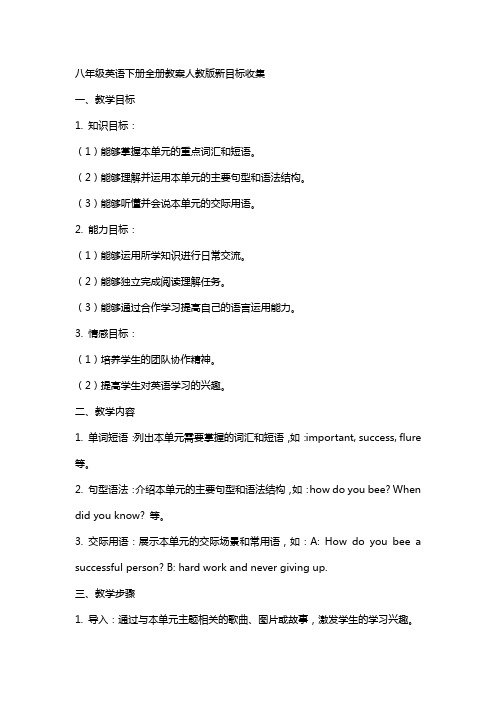
八年级英语下册全册教案人教版新目标收集一、教学目标1. 知识目标:(1)能够掌握本单元的重点词汇和短语。
(2)能够理解并运用本单元的主要句型和语法结构。
(3)能够听懂并会说本单元的交际用语。
2. 能力目标:(1)能够运用所学知识进行日常交流。
(2)能够独立完成阅读理解任务。
(3)能够通过合作学习提高自己的语言运用能力。
3. 情感目标:(1)培养学生的团队协作精神。
(2)提高学生对英语学习的兴趣。
二、教学内容1. 单词短语:列出本单元需要掌握的词汇和短语,如:important, success, flure 等。
2. 句型语法:介绍本单元的主要句型和语法结构,如:how do you bee? When did you know? 等。
3. 交际用语:展示本单元的交际场景和常用语,如:A: How do you bee a successful person? B: hard work and never giving up.三、教学步骤1. 导入:通过与本单元主题相关的歌曲、图片或故事,激发学生的学习兴趣。
2. 呈现:介绍本单元的主要词汇、短语、句型和语法结构。
3. 练习:通过听力、口语、阅读和写作等多种形式,让学生充分练习本单元的知识点。
4. 应用:设计真实的交际场景,让学生运用本单元的知识进行实际交流。
四、教学评价1. 课堂参与度:观察学生在课堂上的积极参与情况和合作程度。
2. 作业完成情况:检查学生课后作业的完成质量和速度。
3. 测验成绩:定期进行单元测验,评估学生的学习效果。
五、课后作业1. 抄写本单元的词汇和短语。
2. 造句运用本单元的句型和语法结构。
3. 编写一段对话或短文,运用本单元的交际用语。
4. 预习下一单元的内容。
六、教学资源1. 教材:八年级英语下册人教版新目标。
2. 辅助材料:多媒体课件、听力材料、练习题、单词卡片等。
3. 网络资源:相关视频、音频、文章等。
七、教学方法1. 任务型教学法:通过完成各种真实的任务,提高学生的语言运用能力。
新目标八年级英语下册全册电子版教案

人教版新目标(新)八年级下册电子教案Unit 1What's the matter?第一课时Section A (1a-2d)1.重点单词:matter,back,sore,throat,stomachache,foot,neck,stomach,fever,lie,rest,cough,Xray,toothache,headache2.重点短语:have a sore throat,have a stomachache,have a cold,lie down,take one's temperature,have a fever,go to a doctor3.重点句式:—What's the matter?—She talked too much yesterday and didn't drink enough water.She has a very sore throat now.You should drink some hot tea with honey.It doesn't sound like you have a fever.You need to take breaks away from the computer.I think I sat in the same way for too long without moving.If your head and neck still hurt tomorrow,then go to a doctor.1.重点短语和句型2.询问对方身体状况的句型及答语询问对方身体状况的句型及答语一、预习课本P1-2新单词并背诵,完成下面的汉译英。
1.问题____________ 2.背部____________3.疼痛的____________ 4.嗓子____________5.胃痛____________ 6.脚____________7.脖子____________ 8.胃____________9.发烧____________ 10.平躺____________11.休息____________ 12.咳嗽____________13.X光____________ 14.牙疼____________15.头疼____________二、认真预习1a-2d找出下列短语和句型。
新目标人教版英语八年级下册教案(全册)

人教版八年英语下册教案Unit 1 What’s the matter?Teaching goals:1.词汇.让学生熟记这些单词,能够很熟练地指出表示身体部位的某些单词.2.能够用所学的单词谈论身体并且能给出中肯的建议.3.通过听力练习,争取能够提高学生的听力能力. Important points:1.words .2.Sentences:I have a headache. You should go to bed.He has a stomachache.He shouldn’t go to bed.She has a toothache.She should see a dentist.Difficulty points:How to talk about the health and give the advice .Period 1Teaching procedures:Step 1 Leading in1.sing a song and do some actions2.Play a game and revise some words we have learned.3.(Today we’ll learn some parts of the body .)Look at the picture and teach new words.Step 2 Pre-task1.Read the new words by the Ss first .2.Then check the Ss if they can read the new words by themselves correctly .if there is a mistakes ,correct .3.Practice reading the new words .Give them 6 minutes .4.Have a competition between boys and girls .Write the words you remembered just now on the blackboard .Page7, 1a.Do this part by the Ss first. Write the correct letter after the name of each body part on the list Play a game .All the Ss close your books ,we’ll have a instructor to say :Touch your nose /head /right ear … .Let’s see which student do it correctly and quickly .First all the Ss do this game .Then have competitions between boys and girls .5 boys and 5girls to the front to do what the instructor said .if you are wrong ,please go back to your seats ,the last one who stands at the front is the winner .Step 3 While-task1.Look at the picture and learn the main sentences.A: What’s the matter with you ?B: I have a cold.2. SB Page 7,1c Look at the pictures , work in pairsand act out.3. SB Page 7, 1b .(1) Listen and check the answers .(2) Listen and fill in the blanks.Step 4 Post-task同桌之间设计一个医生与病人之间的对话.Step 5. Exercises in classPeriod 2Teaching procedures :Step 1 Leading in1.Revise : Ask several pairs of students to the frontof the classroom to act out the dialogue:What’s the matter with you ?I have a sore throat.Then ask others : What’s the matter with him/her ?Help Ss answer : He has a sore throat. He should drink lots of water.2.look at pictures and practise the dialogue.Step 2 While-taskSB Page 8, 2a1.Point out the eight items in this activity .Read theitem to the class .Ss repeat .2.There are different conversations .Listen carefully .people are talking about health problems they have and getting advice .3.Match the problems with the advice .4.Check the answers .SB Page 8, 2b .Pay attention to the four pictures .1.Each of these pictures illustrates one of the conversations .2.Play the tape ,write the missing words on the blank lines .3.Play the tape again and check the answers .4.Pairwork. Practice reading the dialogues in the pictures .Take turns having the problem and giving the advice .5.Practice reading the dialogue in 2c ,and make their onw conversations .6.Act out the dialogue .SB Page 9, 3a .1.Point out the picture and ask Ss to describe it .(There is a boy sitting on a bench .He’s sick .A teacher is talking to him )2.Pay attention to the dialogue and the blanks in the dialogue .3.Fill in the blanks in the conversation .4.Go over the answers.5.Practice reading the dialogue with a student, then work in pairs .Step 3 Post-taskSB Page 9 , 3b .1.Look at the picture and make your own dialogues setting 3a as an example .2.Act out the dialogue .Ask some pairs to come to the front to act out their onw dialogues .SB Page 9, Part 4.1.Read the instructions and demonstrate what a “mime”is .2.Read the dialogue by the Ss .3.Ask a student to come to the front and mime anillness ,the other Ss guess what the illness is .4.Ask one student to give advice .5.Give several students an opportunity to come to the front and mime an illness .Step 4Exercises in classHomework1.When you had some problems. Please remember what the doctor said .Remember the new words .Period 3Teaching procedures :Step 1 Leading1.Play the game :One student mimes an illness , the other students guess the illness and give advice .What’s the matter? Do you have a sore throat ?2. Revise how to talk about health and give advice. Step 2 Pre-taskSB Page 10 ,1a .1.Look at the picture .Point out the four new words and expressions .Say each word and ask Ss to repeat .2.The first picture .Explain something about it using one of the four words and expressions .3.Match the words with the pictures by the Ss .4.Check the answers .5.Practice reading and make sure the Ss understand the meaning of the words .SB Page 10 ,1b1.Read the four sentences ,Ss practice reading .2.Look at the picture and match each picture with advice.3.Check the answerStep 3 While-taskSB Page 10 ,2a & 2b .1.First ,make sure the Ss understand what they will hear .2.Then read the four names3.Listen and write the problems on the bland lines .If possible ,write what each person “should” and “shouldn’t” do for their problem.4.Check the answers .Step 4 Post-taskSB Page 10,2c .1.Ask two students to read the conversation to the class .2.Pairwork .Make conversations with your partner .3.Act out the conversations for the class .4.Write two dialogues in the exercise book .5.Exercises in classPeriod 4Teaching procedures :Step 1 LeadingDiscussion: how to keep healthy.Step 2 While taskSB Page 11, 3a1.Read the article and fill in the form.2.Check the answers .3.Explanation4.ExercisesStep 3 Post taskSB Page 11, 3bLet the Ss read the paragraph and fill in the blanks .Check the answers .SB Page 11 ,Part 4.Play the gamePeriod 5Self checkSB Page 12 , Part 1 .1.Fill in the blanks on their own .2.Make your own sentences with the words .SB Page 12, Part 2.Read the letter .Make sure Ss can understand it .Step 6 Homework1.Remember the words in this unit .2. Do the exercises on Pages 6-8of the workbook .【课后反思】Unit 2 I’ll help clean up the cityparksUnit 2 Section A 1a-Grammar Focus【学习目标】1.重点词汇用法及短语动词用法。
八年级英语下册全册教案人教版新目标收集
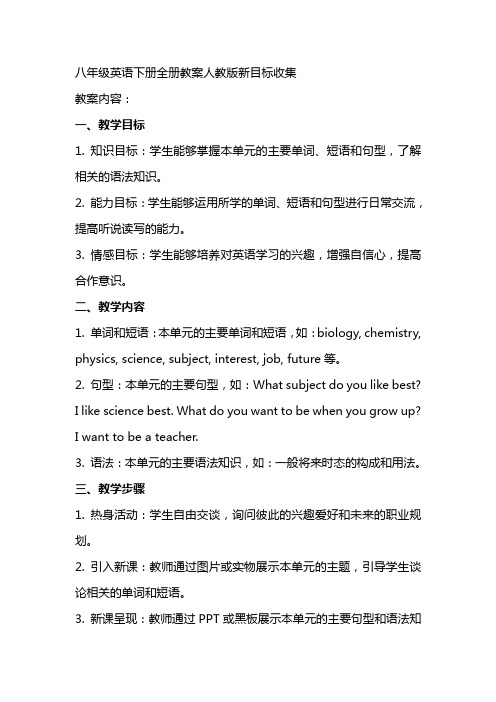
八年级英语下册全册教案人教版新目标收集教案内容:一、教学目标1. 知识目标:学生能够掌握本单元的主要单词、短语和句型,了解相关的语法知识。
2. 能力目标:学生能够运用所学的单词、短语和句型进行日常交流,提高听说读写的能力。
3. 情感目标:学生能够培养对英语学习的兴趣,增强自信心,提高合作意识。
二、教学内容1. 单词和短语:本单元的主要单词和短语,如:biology, chemistry, physics, science, subject, interest, job, future等。
2. 句型:本单元的主要句型,如:What subject do you like best?I like science best. What do you want to be when you grow up?I want to be a teacher.3. 语法:本单元的主要语法知识,如:一般将来时态的构成和用法。
三、教学步骤1. 热身活动:学生自由交谈,询问彼此的兴趣爱好和未来的职业规划。
2. 引入新课:教师通过图片或实物展示本单元的主题,引导学生谈论相关的单词和短语。
3. 新课呈现:教师通过PPT或黑板展示本单元的主要句型和语法知识,让学生进行模仿和练习。
4. 小组活动:学生分组进行讨论,用所学的单词、短语和句型进行交流。
5. 课堂练习:教师设计相关的练习题,让学生进行听、说、读、写的训练。
6. 总结反馈:教师对本节课的内容进行总结,并对学生的表现进行评价和反馈。
四、作业布置1. 抄写本节课的单词和短语。
2. 完成本节课的练习题。
3. 预习下一节课的内容。
五、教学反思教师在课后对本节课的教学进行反思,分析教学效果和学生的学习情况,找出需要改进的地方,为下一节课的教学做好准备。
六、教学评估1. 课堂观察:教师在课堂上观察学生的学习态度、参与程度和语言运用能力。
2. 练习题反馈:教师对学生的练习题进行批改,了解学生的学习效果。
人教版新目标八年级下册英语全册精品教学设计(119页)
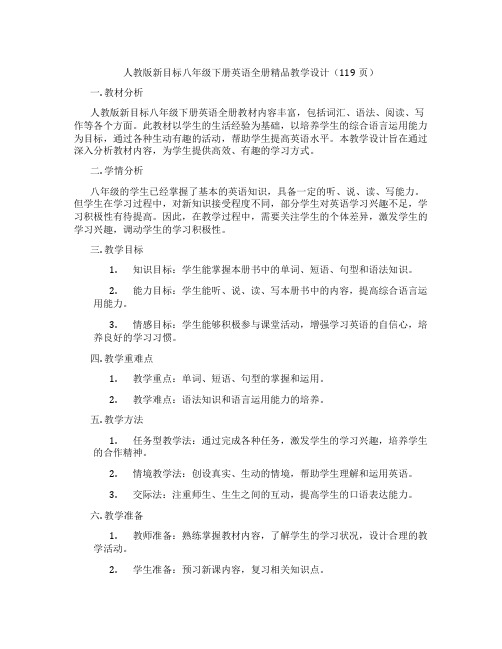
人教版新目标八年级下册英语全册精品教学设计(119页)一. 教材分析人教版新目标八年级下册英语全册教材内容丰富,包括词汇、语法、阅读、写作等各个方面。
此教材以学生的生活经验为基础,以培养学生的综合语言运用能力为目标,通过各种生动有趣的活动,帮助学生提高英语水平。
本教学设计旨在通过深入分析教材内容,为学生提供高效、有趣的学习方式。
二. 学情分析八年级的学生已经掌握了基本的英语知识,具备一定的听、说、读、写能力。
但学生在学习过程中,对新知识接受程度不同,部分学生对英语学习兴趣不足,学习积极性有待提高。
因此,在教学过程中,需要关注学生的个体差异,激发学生的学习兴趣,调动学生的学习积极性。
三. 教学目标1.知识目标:学生能掌握本册书中的单词、短语、句型和语法知识。
2.能力目标:学生能听、说、读、写本册书中的内容,提高综合语言运用能力。
3.情感目标:学生能够积极参与课堂活动,增强学习英语的自信心,培养良好的学习习惯。
四. 教学重难点1.教学重点:单词、短语、句型的掌握和运用。
2.教学难点:语法知识和语言运用能力的培养。
五. 教学方法1.任务型教学法:通过完成各种任务,激发学生的学习兴趣,培养学生的合作精神。
2.情境教学法:创设真实、生动的情境,帮助学生理解和运用英语。
3.交际法:注重师生、生生之间的互动,提高学生的口语表达能力。
六. 教学准备1.教师准备:熟练掌握教材内容,了解学生的学习状况,设计合理的教学活动。
2.学生准备:预习新课内容,复习相关知识点。
3.教学资源:多媒体课件、教材、练习册等。
七. 教学过程1.导入(5分钟)通过与本课主题相关的歌曲、图片或故事,引导学生进入学习状态,激发学生的学习兴趣。
2.呈现(10分钟)教师展示本课的主要知识点,如单词、短语、句型等,并用生动有趣的方式呈现,帮助学生理解和记忆。
3.操练(15分钟)学生分组进行练习,运用所学知识点进行互动,教师巡回指导,纠正发音和语法错误。
新目标英语八年级下册全套教案(免费下载)
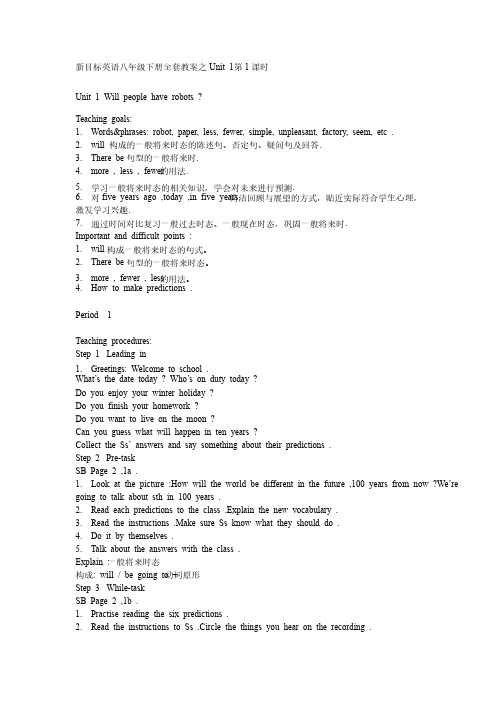
课时新目标英语八年级下册全套教案之Unit 1第1课时Unit 1 Will people have robots ? Teaching goals: 1. Words&phrases: robot, paper, less, fewer, simple, unpleasant, factory, seem, etc . 2. will 构成的一般将来时态的陈述句、否定句、疑问句及回答. 3. There be 句型的一般将来时. 4. more , less , fewer 的用法. 5. 学习一般将来时态的相关知识,学会对未来进行预测. 6. 对five years ago ,today ,in five years 简洁回顾与展望的方式,贴近实际符合学生心理,激发学习兴趣. 7. 通过时间对比复习一般过去时态、一般现在时态,巩固一般将来时. Important and difficult points : 1. will构成一般将来时态的句式。
构成一般将来时态的句式。
2. There be 句型的一般将来时态。
句型的一般将来时态。
3. more , fewer , less 的用法。
的用法。
4. How to make predictions . Period 1 Teaching procedures: Step 1 Leading in 1. Greetings: Welcome to school . What’s the date today ? Who’s on duty today ?Do you enjoy your winter holiday ? Do you finish your homework ? Do you want to live on the moon ? Can you guess what will happen in ten years ? Collect the Ss’ answers and say something about their predictions .Step 2 Pre-task SB Page 2 ,1a . 1. Look at the picture :How will the world be different in the future ,100 years from now ?We’re going to talk about sth in 100 years . 2. Read each predictions to the class .Explain the new vocabulary . 3. Read the instructions .Make sure Ss know what they should do . 4. Do it by themselves . 5. Talk about the answers with the class . Explain :一般将来时态一般将来时态一般将来时态动词原形构成: will / be going to +动词原形Step 3 While-task SB Page 2 ,1b . 1. Practise reading the six predictions . 2. Read the instructions to Ss .Circle the things you hear on the recording . 3. Play the tape twice . 4. Play the tape a third time .At the same time ,check the answers . SB Page 2 , 1c . 1. Pay attention to the dialogues . 2. Read the dialogues fluently . 3. Pairwork .Work in pairs to make predictions according to the sample . 4. Ask several pairs to share their conversations to the class . SB Page 3 , 2a & 2b . 1. Read the predictions . 2. Read the instructions and point out the sample answer . 3. Play the tape twice .Ss circle the word they hear in each sentences: more , less , fewer . 4. Check the answers . 的区别。
八年级英语新目标下全册教案

Unit 1: Greetings and IntroductionsTopic: Greetings and IntroductionsAim: To introduce basic greetings and introduce oneselfLanguage Skills: Listening, Speaking, Reading, WritingObjectives:1. Students will be able to greet people in different ways.2. Students will be able to introduce themselves and others.3. Students will be able to ask and answer simple questions about personal information.4. Students will be able to write a short paragraph introducing themselves.Materials:- Teacher’s edition of New Target English 8A textbook- Student edition of New Target English 8A textbook- Audio recordings of greetings and introductions- Whiteboard and markers- Flashcards with vocabulary wordsProcedure:Warm-up Activity:1. Greet the students using different greetings, such as "Good morning," "Hello," and "How are you?" Have the students respond using the appropriate response.2. Write the different greetings on the board and ask students to match them with the correct response.Introduction:1. Show flashcards with pictures of different greetings and elicit their meanings from students.2. Play an audio recording of greetings and have students listen and repeat the greetings.3. Have students practice the greetings in pairs, taking turns greeting each other and responding.Listening Activity:1. Play an audio recording of a dialogue where two people introduce themselves to each other.2. Have students listen and fill in the missing information in the dialogue.3. Check the answers as a class.Speaking Activity:1. Have students work in pairs. One student will be StudentA and the other will be Student B.2. Give each pair a set of flashcards with different greetings and introductions.3. Student A will choose a flashcard and greet Student B using the greeting on the card.4. Student B will respond and introduce themselves using the introduction on the card.5. Students will switch roles and continue until they have used all the flashcards.Reading Activity:1. Distribute the New Target English 8A textbook to each student.2. Instruct students to read the dialogues on pages 10-11.。
八年级英语下册全册教案人教版新目标
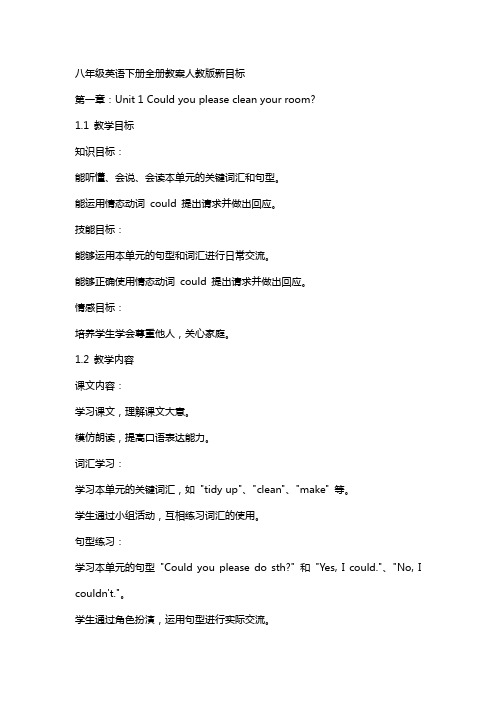
八年级英语下册全册教案人教版新目标第一章:Unit 1 Could you please clean your room?1.1 教学目标知识目标:能听懂、会说、会读本单元的关键词汇和句型。
能运用情态动词could 提出请求并做出回应。
技能目标:能够运用本单元的句型和词汇进行日常交流。
能够正确使用情态动词could 提出请求并做出回应。
情感目标:培养学生学会尊重他人,关心家庭。
1.2 教学内容课文内容:学习课文,理解课文大意。
模仿朗读,提高口语表达能力。
词汇学习:学习本单元的关键词汇,如"tidy up"、"clean"、"make" 等。
学生通过小组活动,互相练习词汇的使用。
句型练习:学习本单元的句型"Could you please do sth?" 和"Yes, I could."、"No, I couldn't."。
学生通过角色扮演,运用句型进行实际交流。
1.3 教学步骤Step 1:热身活动(5分钟)教师与学生进行简单的对话,询问学生周末的安排。
学生用"I will" 或"I'm going to" 表达自己的计划。
Step 2:新课导入(10分钟)教师展示课文图片,引导学生预测课文内容。
学生听课文录音,跟读并模仿语音语调。
Step 3:词汇学习(10分钟)教师引导学生学习本单元的关键词汇,并用例句展示用法。
学生通过小组活动,互相练习词汇的使用。
Step 4:句型练习(10分钟)教师引导学生学习本单元的句型,并用例句展示用法。
学生通过角色扮演,运用句型进行实际交流。
Step 5:巩固练习(10分钟)教师设计练习题,学生分组进行比赛,巩固本节课所学内容。
Step 6:课堂小结(5分钟)学生提问,教师解答。
Step 7:作业布置(5分钟)教师布置作业,要求学生复习本节课的内容,并练习使用新学的词汇和句型。
新目标八年级英语下全册教案

教案一Teaching goals:2.To practice listening, speaking, reading and writing skills through various activities.Teaching key points:2. The formation and usage of the simple present tense.3. Using the interrogative form to ask for personal information.Teaching difficult points:1. Correctly using the simple present tense.2. Understanding and using the interrogative form in sentences.Teaching procedures:Step 1: Warm-up1. Greet the students and have a short conversation with them using questions like "How are you today? What's your name? How old are you?"2. Ask students to work in pairs and talk about their favorite subjects in school for a few minutes.Step 2: Presentation1. Show some pictures of people doing different activities and ask students to guess what they are doing.2. Introduce the key vocabulary and phrases related to the activities in the pictures. Write them on the blackboard and ask students to repeat after you.3. Present the formation and usage of the simple present tense. Write some example sentences on the blackboard and explain the rules.Step 3: Practice1. Play an audio recording of the conversations in Unit 1. Ask students to listen and write down the missing information.2. Provide students with a worksheet containing a dialogue between two people. Ask them to fill in the blanks with the correct form of the verb in the simple present tense.3. Divide the class into pairs and ask them to practice asking and answering questions with their partners using the simple present tense.Step 4: Listening and speaking1. Play an audio recording of a conversation between a student and a teacher. Ask students to listen and answer the questions related to the conversation.2. Provide students with another worksheet containing a dialogue between a student and a teacher. Ask them to work in pairs, taking turns playing the roles of the student and the teacher and practice the conversation.Step 5: Reading and writing2. Provide students with a writing task. Ask them to write a short paragraph about themselves using the simple present tense.Step 6: Summary and homework1. Review the new words, key phrases and grammar points.2. Assign homework: Ask students to write a conversation between two people, asking and answering questions about their personal information.教案二Teaching goals:2.To practice listening, speaking, reading and writingskills through various activities.Teaching key points:2. Describing family members using possessive adjectives.3. Using the correct form of "be" verb to describe family members.Teaching difficult points:1. Understanding and using possessive adjectives correctly.2. Using the correct form of "be" verb when describing family members.Teaching procedures:Step 1: Warm-up1. Greet the students and ask them about their family members. For example, "How many people are there in your family? Do you have any brothers or sisters?"Step 2: Presentation1. Show pictures of family members and introduce the key vocabulary and phrases related to family members. Write them on the blackboard and ask students to repeat after you.2. Teach students how to use possessive adjectives to describe family members. Write some example sentences on the blackboard and explain the rules.Step 3: Practice1. Play an audio recording of the conversations in Unit2. Ask students to listen and fill in the missing information.2. Provide students with a worksheet containing a conversation about a family. Ask them to read the conversation and fill in the blanks with the correct form of the verb "be" and the correct possessive adjective.3. Divide the class into small groups and ask them to createa dialogue about their own family using the vocabulary and grammar they have learned.Step 4: Listening and speaking1. Play an audio recording of a conversation between two friends talking about their family members. Ask students to listen and answer the questions related to the conversation.2. Provide students with another worksheet containing a dialogue. Ask them to work in pairs, taking turns playing the roles of the friends and practice the conversation.Step 5: Reading and writing2. Provide students with a writing task. Ask them to write a short paragraph about their family members using possessive adjectives and the correct form of the verb "be".Step 6: Summary and homework1. Review the new words, key phrases and grammar points.2. Assign homework: Ask students to write a description of their family members, using possessive adjectives and thecorrect form of the verb "be".。
八年级英语新目标下全册教案

Unit 1 Will people have robots ?Teaching goals:1.Words&phrases: robot, paper, less, fewer, simple, unpleasant, factory, seem, etc .2.will 构成的一般将来时态的陈述句、否定句、疑问句及回答.3.There be 句型的一般将来时.4.more , less , fewer 的用法.5.学习一般将来时态的相关知识,学会对未来进行预测.6.对five years ago ,today ,in five years 简洁回顾与展望的方式,贴近实际符合学生心理,激发学习兴趣.7.通过时间对比复习一般过去时态、一般现在时态,巩固一般将来时.Important and difficult points :1.will构成一般将来时态的句式。
2.There be 句型的一般将来时态。
3.more , fewer , less 的用法。
4.How to make predictions .Period 1Teaching procedures:Step 1 Leading in1.Greetings: Welcome to school .What’s the date today ? Who’s on duty today ?Do you enjoy your winter holiday ?Do you finish your homework ?Do you want to live on the moon ?Can you guess what will happen in ten years ?Collect the Ss’ answers and say something a bout their predictions .Step 2 Pre-taskSB Page 2 ,1a .1.Look at the picture :How will the world be different in the future ,100 years from now ?We’re going to talkabout sth in 100 years .2.Read each predictions to the class .Explain the new vocabulary .3.Read the instructions .Make sure Ss know what they should do .4.Do it by themselves .5.Talk about the answers with the class .Explain :一般将来时态构成: will / be going to +动词原形Step 3 While-taskSB Page 2 ,1b .1.Practise reading the six predictions .2.Read the instructions to Ss .Circle the things you hear on the recording .3.Play the tape twice .4.Play the tape a third time .At the same time ,check the answers .SB Page 2 , 1c .1.Pay attention to the dialogues .2.Read the dialogues fluently .3.Pairwork .Work in pairs to make predictions according to the sample .4.Ask several pairs to share their conversations to the class .SB Page 3 , 2a & 2b .1.Read the predictions .2.Read the instructions and point out the sample answer .3.Play the tape twice .Ss circle the word they hear in each sentences: more , less , fewer .4.Check the answers .学生探究: less , fewer 的区别。
新人教版新目标八下英语全册教案

教学难点
掌握重点词汇和 短语的用法
理解课文中的长 句和复杂句型
提高听力和口语 表达能力
掌握语法知识, 尤其是时态和语 态的用法
突破方法
针对重点:强 化练习和讲解
针对难点:采 用多种教学方 法,如情景教 学、游戏教学
等
创新教法:采 用新颖的教学 手段,如多媒 体教学、翻转
课堂等
情感教育:注 重培养学生的 情感态度和价 值观,提高学 生的学习兴趣
教学目标:通过本节课的学习, 学生能够掌握重点词汇和句型, 提高听说读写能力。
教学方法:采用多种教学方法, 如讲解、示范、小组讨论、游戏 等,激发学生的学习兴趣和积极 性。
添加标题
添加标题
添加标题
添加标题
教学内容:围绕教材内容展开, 包括单词、语法、课文、练习等 环节。
教学评价:通过课堂表现、作业、 测试等方式评价学生的学习成果, 及时反馈和指导。
添加标题
添加标题
添加标题
添加标题
教学内容:本册书共包含10个单 元,涉及学校生活、旅游、环保、 健康等多个话题,注重培养学生 的实际运用能力。
教学方法:采用任务型教学法和 情景教学法相结合的方式,通过 多种教学活动和练习来帮助学生 巩固所学知识。
单元分析
单元主题:介绍单元的主题和主要内容 教学目标:明确单元的教学目标,包括知识、技能、情感等方面的目标 重点与难点:分析单元的重点和难点,以及如何突破这些重点和难点 课时安排:合理安排单元的课时,确保教学内容的完成和质量
YOUR LOGO
XX,a click to unlimited possibilities
新人教版新目标八下英语全册教案
汇报人:XX
汇报时间:20XX/01/01
八年级英语下册全册教案人教版新目标

八年级英语下册全册教案人教版新目标教案目录:一、Unit 1 Can you play the guitar?二、Unit 2 What's the matter?三、Unit 3 Could you please clean your room?四、Unit 4 What's the weather like today?五、Unit 5 Why do you like pandas?一、Unit 1 Can you play the guitar?1. 教学目标1.1 知识目标1.2 能力目标1.3 情感目标2. 教学重点与难点3. 教学步骤3.1 导入3.2 新课呈现3.3 练习与巩固3.4 拓展与运用4. 课后作业二、Unit 2 What's the matter?1. 教学目标1.1 知识目标1.3 情感目标2. 教学重点与难点3. 教学步骤3.1 导入3.2 新课呈现3.3 练习与巩固3.4 拓展与运用4. 课后作业三、Unit 3 Could you please clean your room?1. 教学目标1.1 知识目标1.2 能力目标1.3 情感目标2. 教学重点与难点3. 教学步骤3.1 导入3.2 新课呈现3.3 练习与巩固3.4 拓展与运用4. 课后作业四、Unit 4 What's the weather like today?1.1 知识目标1.2 能力目标1.3 情感目标2. 教学重点与难点3. 教学步骤3.1 导入3.2 新课呈现3.3 练习与巩固3.4 拓展与运用4. 课后作业五、Unit 5 Why do you like pandas?1. 教学目标1.1 知识目标1.2 能力目标1.3 情感目标2. 教学重点与难点3. 教学步骤3.1 导入3.2 新课呈现3.3 练习与巩固3.4 拓展与运用4. 课后作业六、Unit 6 Do you want to watch a game?1. 教学目标1.1 知识目标1.2 能力目标1.3 情感目标2. 教学重点与难点3. 教学步骤3.1 导入3.2 新课呈现3.3 练习与巩固3.4 拓展与运用4. 课后作业七、Unit 7 Will you e to my party?1. 教学目标1.1 知识目标1.2 能力目标1.3 情感目标2. 教学重点与难点3. 教学步骤3.1 导入3.2 新课呈现3.3 练习与巩固3.4 拓展与运用4. 课后作业八、Unit 8 I'm going to study puter science.1. 教学目标1.1 知识目标1.2 能力目标1.3 情感目标2. 教学重点与难点3. 教学步骤3.1 导入3.2 新课呈现3.3 练习与巩固3.4 拓展与运用4. 课后作业九、Unit 9 How was your day?1. 教学目标1.1 知识目标1.2 能力目标1.3 情感目标2. 教学重点与难点3. 教学步骤3.1 导入3.2 新课呈现3.3 练习与巩固3.4 拓展与运用4. 课后作业十、Unit 10 Let's play sports!1. 教学目标1.1 知识目标1.2 能力目标1.3 情感目标2. 教学重点与难点3. 教学步骤3.1 导入3.2 新课呈现3.3 练习与巩固3.4 拓展与运用4. 课后作业重点和难点解析一、Unit 1 Can you play the guitar?重点和难点解析:1. 情态动词"can" 的用法和意义,以及其否定和疑问形式。
八年级英语下册全册教案人教版新目标收集

八年级英语下册全册教案人教版新目标收集教案内容:一、Lesson 1: Clothing1.1. 教学目标:学生能够描述不同季节的服装。
学生能够用英语询问和回答关于衣服尺码的问题。
1.2. 教学内容:学习与衣服相关的词汇和短语。
练习描述衣服的尺码和颜色。
完成相关练习题。
二、Lesson 2: Directions2.1. 教学目标:学生能够理解并使用基本的英语方向词汇。
学生能够描述如何到达某个地点。
2.2. 教学内容:学习与方向相关的词汇和短语。
练习描述如何到达某个地点。
完成相关练习题。
三、Lesson 3: School Subjects3.1. 教学目标:学生能够描述自己喜欢的学科和活动。
学生能够用英语表达自己的兴趣和爱好。
3.2. 教学内容:学习与学科和活动相关的词汇和短语。
练习描述自己的学科选择和兴趣爱好。
完成相关练习题。
四、Lesson 4: Rules and Regulations4.1. 教学目标:学生能够描述学校或家庭中的规则和规定。
学生能够用英语表达遵守规则的重要性。
4.2. 教学内容:学习与规则和规定相关的词汇和短语。
练习描述学校或家庭中的规则和规定。
完成相关练习题。
五、Lesson 5: Dly Routine5.1. 教学目标:学生能够描述自己的日常活动。
学生能够用英语表达自己的日常习惯。
5.2. 教学内容:学习与日常活动相关的词汇和短语。
练习描述自己的日常活动和习惯。
完成相关练习题。
六、Lesson 6: Family and Friends6.1. 教学目标:学生能够介绍自己的家庭成员和朋友。
学生能够用英语表达家庭成员和朋友的特征和关系。
6.2. 教学内容:学习与家庭成员和朋友相关的词汇和短语。
练习介绍家庭成员和朋友的特征和关系。
完成相关练习题。
七、Lesson 7: Describing People7.1. 教学目标:学生能够描述人物的外貌和性格特点。
学生能够用英语表达对他人的评价和感受。
八年级英语下册全册教案人教版新目标收集

八年级英语下册全册教案人教版新目标收集教案内容:一、教学目标1. 知识目标:(1)能熟练运用本册所学词汇和语法知识。
(2)能理解并运用本册所学的主要功能项目。
(3)掌握本册所学的主要话题,提高语言运用能力。
2. 能力目标:(1)培养学生的听、说、读、写四项基本技能。
(2)提高学生的语言交际能力,使他们在实际生活中能够运用英语进行沟通。
3. 情感目标:激发学生学习英语的兴趣,培养他们积极向上的学习态度,使他们能够自信地面对英语学习。
二、教学内容1. 重点词汇和短语。
2. 主要功能项目。
3. 主要话题及相关语言运用。
三、教学方法1. 任务型教学法:通过完成各种实际任务,提高学生的语言运用能力。
2. 情境教学法:创设真实的语言环境,让学生在实际情境中学习英语。
3. 交际教学法:注重学生之间的互动,培养他们的语言交际能力。
四、教学步骤1. 热身(5分钟):通过简单的口语练习,引导学生进入学习状态。
2. 呈现(10分钟):利用图片、实物或多媒体等教学资源,展示本节课的主要词汇和短语。
3. 练习(15分钟):通过各种练习活动,让学生巩固所学词汇和短语。
4. 交流(10分钟):分组进行角色扮演或小组讨论,让学生在实际情境中运用所学语言。
5. 总结(5分钟):对本节课所学内容进行简要回顾,强调重点和难点。
五、课后作业1. 复习本节课所学词汇和短语。
2. 完成课后练习题,巩固所学知识。
3. 准备下一节课的预习内容。
4. 鼓励学生进行英语课外阅读,提高他们的阅读能力。
六、教学评价1. 课堂表现评价:观察学生在课堂上的参与程度、发言积极性以及合作意识等,了解他们的学习状态。
2. 课后作业评价:检查学生课后作业的完成情况,评估他们对所学知识的掌握程度。
3. 单元测试评价:定期进行单元测试,分析学生的成绩,找出存在的问题,为下一步教学提供参考。
4. 学生自评和互评:鼓励学生对自己和他人的学习情况进行评价,提高他们的自我认知和团队意识。
新目标八年级英语下册学案全册教案
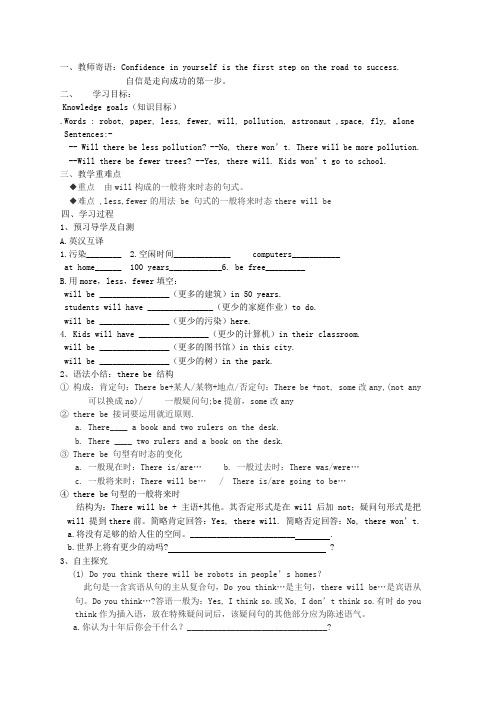
一、教师寄语:Confidence in yourself is the first step on the road to success.自信是走向成功的第一步。
二、学习目标:Knowledge goals(知识目标).Words : robot, paper, less, fewer, will, pollution, astronaut ,space, fly, alone Sentences:--- Will there be less pollution? --No, there won’t. There will be more pollution.--Will there be fewer trees? --Yes, there will. Kids won’t go to school.三、教学重难点◆重点由will构成的一般将来时态的句式。
◆难点 ,less,fewer的用法 be 句式的一般将来时态there will be四、学习过程1、预习导学及自测A.英汉互译1.污染________2.空闲时间_____________ computers___________at home______ 100 years____________6. be free_________B.用more,less,fewer填空:will be ________________(更多的建筑)in 50 years.students will have _______________(更少的家庭作业)to do.will be ________________(更少的污染)here.4. Kids will have ________________(更少的计算机)in their classroom.will be ________________(更多的图书馆)in this city.will be ________________(更少的树)in the park.2、语法小结:there be 结构①构成:肯定句:There be+某人/某物+地点/否定句:There be +not, some改any,(not any可以换成no)/ 一般疑问句;be提前,some改any② there be 接词要运用就近原则.a. There____ a book and two rulers on the desk.b. There ____ two rulers and a book on the desk.③ There be 句型有时态的变化a. 一般现在时:There is/are…b. 一般过去时:There was/were…c. 一般将来时:There will be… / There is/ar e going to be…④ there be句型的一般将来时结构为:There will be + 主语+其他。
人教版新目标英语八年级下册教案全册(共50份)

人教版新目标英语八年级下册教案全册(共50份)Unit 3 Could you clean up your room?Section B (1a~1e)教学目标【知识与技能】1. 掌握本单元单词并正确使用以下常用表达法:buy some drinks and snacks, borrow some money, invite sb. to the party, make your bed…2. 能熟练掌握并使用下列重点句式:—Could you clean your room? —Yes, I can. —Could I invite my friends to a party? —No, you can’t have the party•Unit 3 Could you clean up your room?Section B (2a~3b)教学目标【知识与技能】1. 学习并掌握新词汇:chore; waste, provide, depend, drop等。
2. 能正确使用以下常用表达:a waste of time, provide sth. for sb., mind doing sth., take care of, depend on等。
3. 学会使用以下句型:they don’t have time… they should spend time on… it’s not enough to…, the+比较级,•Unit 3 Could you clean up your room?Section B (self check)教学目标【知识与技能】1. 学习并掌握新词汇:fair, unfair等。
2. 能正确使用以下常用表达:do chores; it’s fair/unfair for sb. to do sth.3. 注意正确搭配下列重点句式:do, clean, make, fold, sweep, take out4. 能熟练掌握并使用下列重点句式:I think/believe/agree that…; Can I/you…?【情感、态度与价值观】让学生学会征求他人的许可,并学会有礼貌地请•Unit 3 Could you please clean your room?Section A(1a~2d)教学目标【知识与技能】1. 掌握重点词汇rubbish,fold,sweep, floor, mess, take out the rubbish, fold the clothes, sweep the floor, all the time, make the bed, go out for dinner2. 掌握以下句型: 1.—Could you please sweep the floor? —Yes,sure.2.—Co•Unit 3 Could you please clean your room?Section A(3a~4c)教学目标【知识与技能】1. 学习掌握下列词汇:throw, neither, shirt, pass, borrow, lend, finger, hate, while, throw down, take the dog for a walk, be angry with, all the time, as soon as2. 句型:① For one week, she did not do any housework and neither did I.②—Could I b。
八年级英语下册全册教案人教版新目标收集

八年级英语下册全册教案人教版新目标收集教案内容:一、教学目标1. 知识目标:(1)能够熟练运用本单元的单词和短语进行日常交流。
(2)能够理解并运用本单元所学的语法知识。
(3)能够阅读并理解与本单元主题相关的文章。
2. 能力目标:(1)能够听懂并能够使用本单元所学的日常用语。
(2)能够就本单元的主题进行简单的交流和讨论。
(3)能够独立完成与本单元相关的小组活动。
二、教学重难点1. 重点:本单元的单词和短语,以及语法知识。
2. 难点:如何正确运用语法知识进行日常交流。
三、教学方法1. 情境教学法:通过创设各种真实的生活情境,让学生在实践中学习和运用英语。
2. 任务型教学法:通过完成各种任务,让学生在实际操作中学习和运用英语。
3. 小组合作学习:通过小组活动,让学生在互动中学习和运用英语。
四、教学准备1. 教师准备:备好本单元的教学课件和教学素材。
2. 学生准备:预习本单元的单词和短语,预习相关的文章。
五、教学过程1. 导入:通过与本单元主题相关的问题,引导学生进入学习状态。
2. 新课呈现:通过课件和实物展示,教授本单元的单词和短语。
3. 语法讲解:通过例句和练习,讲解本单元的语法知识。
4. 实践环节:通过小组活动,让学生运用所学知识进行实际操作。
六、教学评价1. 课堂评价:通过观察学生的课堂表现,了解学生的学习状态和掌握程度。
2. 作业评价:通过批改学生的作业,了解学生对知识的掌握情况。
3. 小组活动评价:通过观察学生在小组活动中的表现,了解学生的合作能力和交流能力。
七、教学拓展1. 单词和短语:引导学生通过阅读和听力练习,积累更多的词汇和短语。
2. 语法知识:通过课后练习和模拟测试,巩固所学的语法知识。
3. 主题讨论:引导学生就本单元的主题进行深入的讨论和研究。
八、教学反馈1. 学生反馈:通过问卷调查或面谈,了解学生的学习需求和反馈。
2. 家长反馈:通过电话或邮件,了解学生的学习情况和家长的期望。
- 1、下载文档前请自行甄别文档内容的完整性,平台不提供额外的编辑、内容补充、找答案等附加服务。
- 2、"仅部分预览"的文档,不可在线预览部分如存在完整性等问题,可反馈申请退款(可完整预览的文档不适用该条件!)。
- 3、如文档侵犯您的权益,请联系客服反馈,我们会尽快为您处理(人工客服工作时间:9:00-18:30)。
【重点、难点】重点词汇用法及短语动词用法。
【导学指导】温故知新给下列单词1)-6)加上-ful, 7)-10)加上-less,并写出其汉语意思。
1)use 2)care 3) success 4)beauty5)color6)wonder 7)home 8)help 9)care10)use自主互助学习一、自主预习1. 译一译,读一读,背一背1)饥饿 2)无家可归的 3)标牌4)广告5)创办 6)打扫干净 7)使振奋起来8)分发9)建立,建造 10)推迟 11)想出12)清洁日13) sick children 14)at the food bank15)after-school study program 16)make aplan2. 自主预习完成1a的任务。
二、听力导学1. 听力前准备1)认真阅读1b各句子,弄懂大概含义,并猜一猜空格会填什么内容。
2)看懂2a中五幅图片的内容,用英文把图片反映的内容描述出来。
3)认真阅读2b中句子,猜一猜空格会填什么内容。
2. 听录音仔细听录音内容,完成1b,2a,2b,并核对答案。
3. 重放录音,跟读录音内容。
二、合作探究1. You could help clean up the city parks.1)help作动词,“帮助”。
help sb.(to)do=___________________.帮助某人做某事如:He often helps me(to)studyEnglish.=____________________________.2)help作名词,“帮助”。
如:______________________. 谢谢你的帮助。
3) clean 可用作形容词,意为“清洁的,干净的”,此外clean 可用作动词,用于以下词组:clean up 打扫清洁或收拾整齐,整理。
clean out 打扫某物内部(如:房间,抽屉,箱子等)clean-up (名词)打扫,清洁。
练一练:It’s time for you to _________________ your bedroom.I will help you _____________ the school.Tomorrow is _____________________day, everyone should try to do some cleaning.2. sick和ill的用法区别sick是形容词,"生病的",同义词是ill。
区别在于sick在句中可做语和语,而ill只能做语。
如:His father was /sick yesterday, so he didn't go to work.他的父亲昨天病了,因此他没有去上班。
Tom has looked after the sick girl for a week. 汤姆看顾那个生病的小女孩已经一星期了。
别的,当ill意为"坏的,恶劣的"时,在句中可做定语。
如:He is an ill child.他是一个坏孩子。
3.set up, establish和build的用法区别:1) set up意为“开办,建立",主要用于组织、机构、公司、学校”等。
相当于open up或build up.2) establish意为“建立,建造,设立”,一般指建立某个国家、组织、团体等概念的东西。
相当于found(建立)。
3) build意为“制作,设置装备摆设”,是一般用语,偏重动工建筑,常指制作大东西,如房屋、桥梁、道路等。
试比较:set up a school____________ build a school_____________China was founded in1949. 。
4. We can't put off making a plan.1)put off"推迟、取消(会议,约会等),动副词组,后跟动词时应用其-ing形式,代词作宾语需放在put和off中间。
例如:________________until tomorrow what can be done today.今天可以做的事情不要推到明天。
Please don't put off ___________your homework.请你们不要拖延做作业。
2) make a plan 意为____________. make a plan to dosth________________.3) 归纳关于put的词组。
【课堂练习】从方框中选择恰当的词组,并用其适当形式填空。
1.He has a lot of work to do, so he has to_______________going to the doctor.2.Could you help me _________________ these new books?3.Don’t worry. I’ll help ______________your room.4.Let’s _______________the sick kids in the hospital.5.In the end, Grandma ________________ a good idea.6.Would you please not _______________signs here?She had a rest . 她每5分钟就休息一会儿。
三、合作学习1. 角色扮演。
小组合作完成3c的对话。
2. 小组讨论完成Part4。
【课堂练习】找出与划线部分意思相同或相近的选项。
()1.The child looked sad. Let’s cheer him up.A. happyB. make him happierC. shoutedD. give a help()2. We’re going to set up a project to help hungry people.A. startB. give upC. getup D. turn up()3. They need to some ideas.A. think aboutB. help… withC. think upD. think over()4. I’d like to help the kids do their homework.A. help… doingB. help… withC. give a helpD. give a hand()5. When he grows up, he wants to be a doctor for animals.A. great manB. vetC. gooddoctor D. kind of animal【要点归纳】掌握重点词汇、句型的运用,阅读能力的提高。
【拓展练习】单项选择。
()1.Not only ______ run his machine, but _______ repair it.A. can he; he canB. he can; he canC. he can; can heD. can he ; can he()2. Not only _______ polluted but _______ crowded.A. was the city ; were the streetsB. the city was; werethe streetsC. was the city; the streets wereD. the city was; the streets were()3. Not only ______ me to a meal , but also he bought me a present.A. did he inviteB. he invitedC. had he invitedD.he had invited()4. The two girls were very happy because _____ of them had passed the math exam.A. bothB. allC. neitherD. none()5. Did you ______ much money on the car ? A. cost B.pay C. spend D. takeUnit 2 Section B 1 a-2 c【学习目标】 1.听力练习。
2.掌握短语:run out of, take after,fix up, give away.【重点、难点】掌握短语:run out of, take after, fix up, giveaway的运用及听力技能提高。
【导学指导】温故知新用所给词的适当形式填空1)Let’s cheer _______ (they)up, ok?2)I’d like _____ (visit)my English teacher tomorrow.3)I’ll feel good about _______ (help)the old people.4)He _____(spend) every morning _______ (do)somesports.5)They plan ___________ (buy) a big house.自主互助学习一、自主预习1. 译一译,读一读,背一背1)相似的 2)修理 3)修理(短语) 4)与……相像5)用完,耗尽 6)赠送,捐赠2. 自主预习完成1a,1b.(必要时查查字典)二、合作探究1.辩一辩 take after & look like1)take after 由于血缘关系而(外貌、性格等方面)相似,和意义接近。
如:I take after my mother= ___________________________.我像我妈妈。
2) look like 看起来像……(多指外貌),如:He hismother. 他长得像他妈妈。
2. 辩一辩 fix,repair& mendrepair 用于建筑、堤坝、机器、车辆等的修理;fix是美语用法,等于repair; mend一般用于衣服,鞋袜等小东西,偶尔也用于道路、门窗等。
练一练:Can you my bike? 你给我修修自行车行吗?He isa road. 他正在修路。
3. run out of 意为_________________, 相当于 ______________.I have run out of my pocket money. 同义句:________________________________________.三、听力导学Once there was a man who had two children, a boy and a girl. The boy was good-looking but the girl was not. One day they found a mirror and for the first time they saw what they looked like. The boy was very pleased and he said to his sister, “How handsome Iam! I look much nicer than you!” The girl did not like what her brother said and gave him a hard push. “Go away!” she said. Their father saw what was happening. He went up to them and said to the boy, “you must always be good as well look good.” Then to thegirl he said, “My dear, if you help everyone and do your best to please, everyone will love you. It will not matter that you are not as good-looking as your brother.”根据短文内容,判断正(T)误(F)()1. The story is about a woman and his two children.()2. The boy looked very nice and so did the girl.()3. The sister was angry and she pushed her brother away.()4.The father told his son if he could be nice and kind to people and ready to help, everybody would love her()5. The story tells us that the most important thing for a person is to be nice and helpful to peopleUnit 2 Section B 3a-Self Check【学习目标】 1.在课文中加深对短语动词的理解及其用法。
